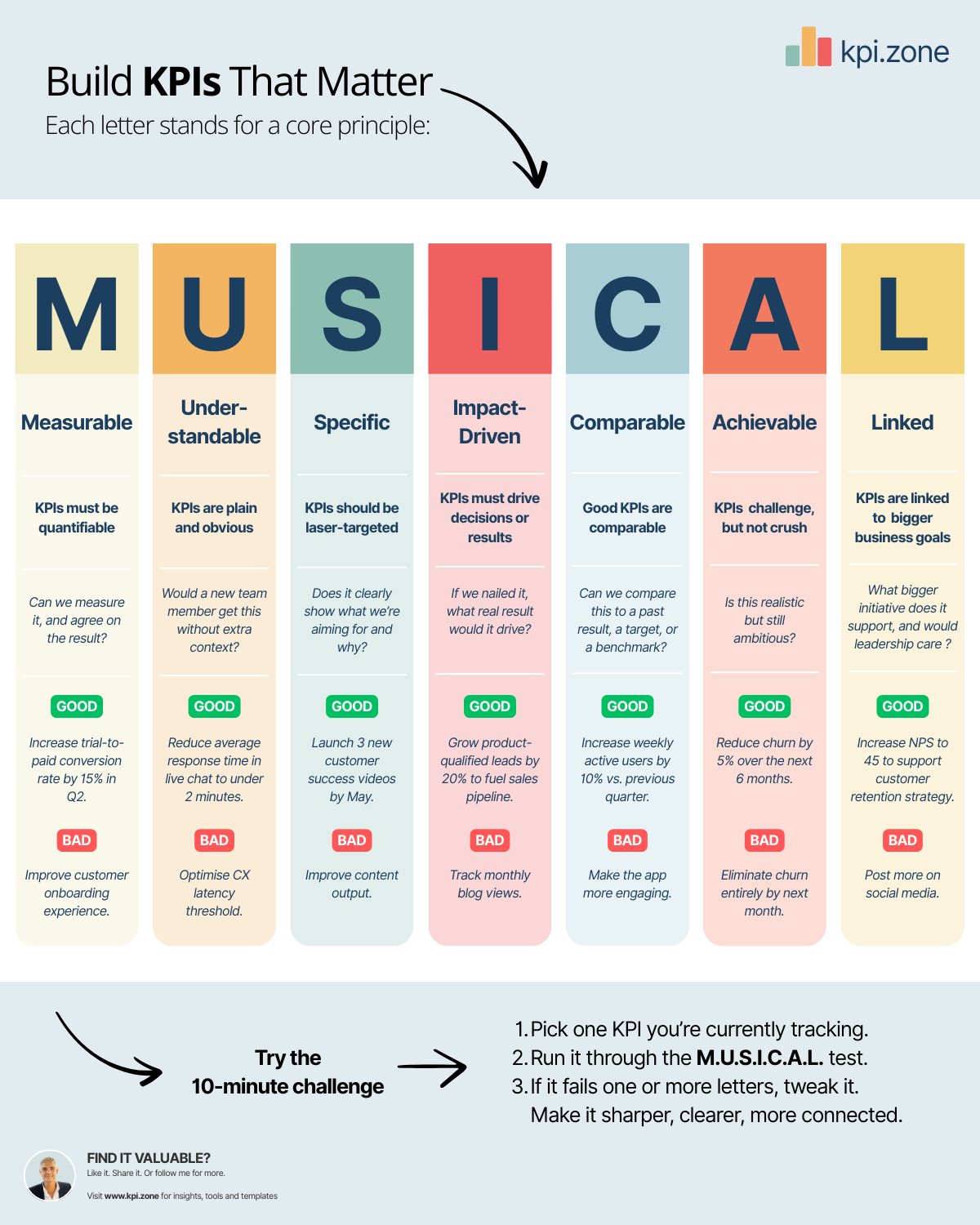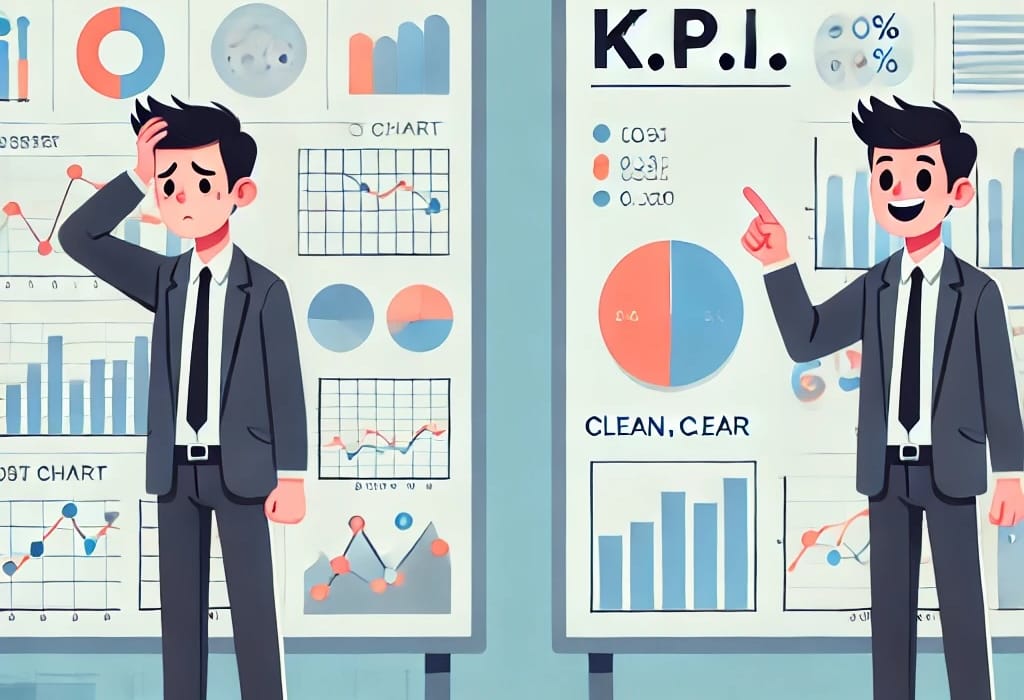Table of Contents
Ever stared at a dashboard full of colourful charts and thought, “Okay... but what do I do with this?”
Same.
I’ve led teams, built products, and sat in more strategy meetings than I can count. And I’ll tell you this: most KPIs are either too vague to act on, too complex to understand, or too disconnected from what actually matters.
We nod at them in meetings, glance at them once a quarter, then go back to guessing what’s working.
But it doesn’t have to be this way.
Let me introduce you to something that changed how I build KPIs: the M.U.S.I.C.A.L. Framework.
It’s simple, powerful, and — most importantly — actionable.
And yeah, the name is a bit cheeky. But that’s the point. Good KPIs should be memorable. So why not make them musical?
What is the M.U.S.I.C.A.L. Framework?
Each letter stands for a core principle that separates useful KPIs from useless clutter:
- M –Measurable
- U – Understandable
- S – Specific
- I – Impact-Driven
- C – Comparable
- A – Achievable
- L – Linked
Let’s break it down, one note at a time.
M – Measurable
If it can’t be measured, it’s not a KPI—it’s a wish.
KPIs must be quantifiable. That means using real numbers, percentages, or time-based targets. Otherwise, how do you know if you’re winning?
✅ Good KPI: “Increase trial-to-paid conversion rate by 15% in Q2.”
❌ Bad KPI: “Improve customer onboarding experience.” Improve how? By when? Compared to what?
Always ask: Can I put a number on this? If not, it’s not ready yet.
U – Understandable
Ever read a KPI and felt like you needed a translator?
KPIs should be plain and obvious. Something your newest hire and your busiest exec can both understand at a glance.
✅ Good KPI: “Reduce average response time in live chat to under 2 minutes.”
❌ Bad KPI: “Optimise CX latency threshold.” (What even is that?)
Ditch the jargon. If it sounds like consultant-speak, rewrite it.
S – Specific
Vague goals kill focus. A KPI should be laser-targeted — no ambiguity, no fluff.
✅ Good KPI: “Launch 3 new customer success videos by May.”
❌ Bad KPI: “Improve content output.” (Improve by how much? On what platform?)
One KPI = One outcome. If your KPI tries to do five things, it’ll do none.
I – Impact-Driven
Here’s the big one: Is your KPI just informative or is it impactful?
Some metrics are nice to know — but they don’t drive decisions or results.
✅ Good KPI: “Grow product-qualified leads by 20% to fuel sales pipeline.”
❌ Bad KPI: “Track monthly blog views.” (Nice, but does it move anything?)
Ask yourself: if we hit this, what will it change? If the answer is “not much”, rethink it.
C – Comparable
Good KPIs let you compare. Across time, teams, campaigns — whatever matters.
✅ Good KPI: “Increase weekly active users by 10% vs. previous quarter.”
❌ Bad KPI: “Make the app more engaging.” (How do you measure that?)
Add a baseline or a target. Make it easy to see progress (or the lack of it).
A – Achievable
Stretch goals? Great. Fantasy metrics? Not so much.
KPIs should challenge, but not crush. If your team hears a goal and immediately laughs — or panics — it’s too far off.
✅ Good KPI: “Reduce churn by 5% over the next 6 months.”
❌ Bad KPI: “Eliminate churn entirely by next month.” (Sure, and I’ll learn Mandarin by Tuesday.)
Use past data to set future targets. Ambition + realism = momentum.
L – Linked
This is where most KPIs fall flat: they’re not connected to strategy.
It’s easy to create metrics in isolation — “post more”, “launch feature X” — but unless they’re tied to a bigger business goal, they don’t mean much.
✅ Good KPI: “Increase NPS to 45 to support customer retention strategy.”
❌ Bad KPI: “Post more on social media.” (Why? To what end?)
Every KPI should ladder up to something strategic. If it doesn’t, cut it or connect it.
Let’s Zoom Out for a Second
This isn’t just a better way to write metrics. It’s a mindset shift.
When your KPIs are M.U.S.I.C.A.L., they do more than report. They drive.
They align your team. They clarify what matters. They force you to get specific about impact.
They stop being noise — and start being levers. And once you see KPIs that way, you won’t go back.
🚀 Try This Today
Here’s your 10-minute challenge:
- Pick one KPI you’re currently tracking.
- Run it through the M.U.S.I.C.A.L. test.
- If it fails one or more letters, tweak it. Make it sharper, clearer, more connected.
You don’t need 50 KPIs. You need a few that move.
Let those KPIs sing.


